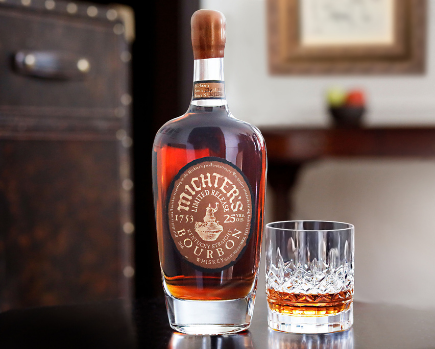Is Michter's 25 year old Bourbon Worth $1000?
Mitcher's 25 Year Bourbon
Kentucky bourbon isn’t supposed to age for 25 years, unless you want it to taste like tree bark. So why are Scotch single malts in their 30s, 40s and even 50s desirable, while a 20 year old bourbon is pushing the outer limits of aging? First off, bourbon must, by law, be aged in new American oak. Those barrels, once used, are then sent all over the world where they’re used to age other spirits, most famously Scotch whisky. By that time, the bourbon has soaked up a lot of the tannins — the stuff that gives whiskey its dry, spicy, woody flavor — from the barrel. Then there’s the climate. Kentucky’s hot summers and freezing winters expand and contract the wood, pushing the liquid in and out of the barrel much more than the fairly constant, chilly climate of Scotland. That’s why a bourbon reaches what many distillers and drinkers think of as its maturity, roughly 6-12 years, when a Scotch whisky of that age can be downright childlike by comparison.
There are, however, exceptions to every rule. And that’s why you’ll see bourbons aged two decades and longer on the shelves of your more upscale liquor stores (often behind glass and under lock and key, due to the price), or being offered at whiskey auctions. That doesn’t mean they all taste good. People who invest in bottles of Pappy Van Winkle’s sought-after bourbons often go for the 23 year old family reserve, but most people who actually drink the stuff will tell you that the 15 year old is better. Some of the most awful bourbons I’ve ever tasted were probably perfectly good a decade before they were finally bottled. In a nutshell, when a bourbon’s age statement makes it old enough to vote or drive a car (though a bottle of bourbon would obviously fail a breathalyzer test), proceed with extreme caution.
Michter’s: a proud history
Which brings us to Michter’s. Though its history can be proudly traced back to colonial times, the story of the brand as we know it today really begins in the 1990s, when the American whiskey industry was mired in a decades-long slump. Current president Joe Magliocco revived the then-defunct name, moved its base of operations from Pennsylvania to Kentucky, and started sourcing aged whiskeys from distilleries that couldn’t move them and didn’t want them. Later on, Michter’s started making its own whiskeys at other brands’ distilleries. Today, the brand has two distilleries of its own in Kentucky, and its whiskeys are some of the most sought-after in the world, rivaling even Pappy in the auction market.
Michter’s was putting out 25 year old bourbons and ryes before American whiskey took off, and they’re still doing it today, although not on any particular schedule. When there’s a barrel or two deemed worthy of release by the Michter’s team — most notably Master of Maturation Andrea Wilson and master distiller Dan McKee — it’s bottled. When the latest 25 Year Old came out this fall, it had been more than three years since the last one, despite the fact that they could have sold out of pretty much anything they decided to stick in a bottle with a “25” label on it. But quality control trumps profits at Michter’s, and it reaffirms their belief that even the rarest of unicorn bottles are meant for drinking, not for sticking on a shelf and admiring. Though at a suggested retail price of $1,000 for the 348 bottles available (emphasis on “suggested,” as the actual price, if you can find a bottle, is already several times that), there’s no shame in treating it as a family heirloom.
We don’t know the provenance of the 25 Year Old Bourbon — which distillery made it and when it was purchased remain secret for legal reasons, and the mashbill has never been made public. But it does taste like a Michter’s, big and robust and flavorful. The nose is quite sweet, with caramel, toffee, creme brûlée, and less wood than a quarter-century in oak had prepared me for. On the palate, it’s rich and intense, with concentrated flavors of dark chocolate, burnt caramel, some chocolate-covered orange peel, and a little vanilla. At its cask strength, a hefty 58.1% ABV, the finish is dry and spicy, but a few drops of water mellow it out and also bring up surprising, subtle notes of pear and melon. The tannins so prevalent in extra-aged bourbon do, of course, show up here — how could they not? — but I didn’t feel like picking splinters out of my tongue after a few sips. It’s definitely an elder statesman as far as bourbon is concerned, but that’s not necessarily a bad thing. Sean Connery was a handsome man when he was 40, and a handsome man at 70. Which one you prefer is entirely subjective.
A grand bourbon for a grand
The million-dollar question, or rather the thousand-dollar question, is whether this bourbon is worth a grand (or far more, depending on the vagaries of the secondary market). Certainly, you can find a terrific bottle of bourbon for a tiny fraction of the price that will be just as enjoyable, if quite different, than Michter’s 25. But anyone who’s seriously in the market for it isn’t buying the damn thing solely for how it tastes. It’s the collectability, the rarity, the sheer improbability of it existing in the first place, the knowledge that a very finite quantity exists. Add up those factors and throw in a lot of disposable income and you’ve got a whiskey that actually lives up to the hype. As for whiskey geeks on a more modest budget, yes, you can live without it. But should an opportunity to taste it ever come your way, don’t pass it up.

